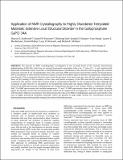Application of NMR crystallography to highly disordered templated materials : extensive local structural disorder in the gallophosphate GaPO-34A
Abstract
We present an NMR crystallographic investigation of two as-made forms of the recently characterised gallophosphate GaPO-34A, which has an unusual framework composition with a Ga : P ratio of 7 : 6 and contains both hydroxide and fluoride anions and either 1-methylimidazolium or pyridinium as the structure-directing agent. We combine previously reported X-ray crystallographic data with solid-state NMR spectroscopy and periodic density functional theory (DFT) calculations to show that the structure contains at least three distinct types of disorder (occupational, compositional and dynamic). The occupational disorder arises from the presence of six anion sites per unit cell, but a total occupancy of these of five, leading to full occupancy of four sites and partial occupancy of the fifth and sixth (which are related by symmetry). The mixture of OH and F present leads to compositional disorder on the occupied anion sites, although the occupancy of some sites by F is calculated to be energetically unfavorable and signals relating to F on these sites are not observed by NMR spectroscopy, confirming that the compositional disorder is not random. Finally, a combination of high-field 71Ga NMR spectroscopy and variable-temperature 13C and 31P NMR experiments shows that the structure directing agents are dynamic on the microsecond timescale, which can be supported by averaging the 31P chemical shifts calculated with the SDA in different orientations. This demonstrates the value of an NMR crystallographic approach, particularly in the case of highly disordered crystalline materials, where the growth of large single crystals for conventional structure determination may not be possible owing to the extent of disorder present.
Citation
Ashbrook , S E , Dawson , D M , Gan , Z , Hooper , J E , Hung , I , Macfarlane , L E , McKay , D , McLeod , L K & Walton , R I 2020 , ' Application of NMR crystallography to highly disordered templated materials : extensive local structural disorder in the gallophosphate GaPO-34A ' , Inorganic Chemistry , vol. Article ASAP . https://doi.org/10.1021/acs.inorgchem.0c01450
Publication
Inorganic Chemistry
Status
Peer reviewed
ISSN
0020-1669Type
Journal article
Description
SEA, DMD, JEH and DM thank the ERC (EU FP7 Consolidator Grant 614290 “EXONMR”) for funding. SEA would like to thank the Royal Society and the Wolfson Foundation for a merit award. The National High Magnetic Field Laboratory is supported by National Science Foundation Cooperative Agreement DMR-1644779 and the State of Florida.Collections
Items in the St Andrews Research Repository are protected by copyright, with all rights reserved, unless otherwise indicated.

